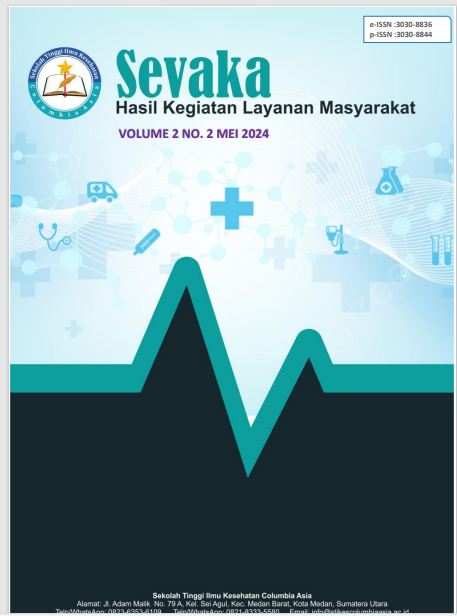Penyuluhan Penerapan K-Means Clustering Dalam Pengelompokan Data Keuangan Rumah Sakit Untuk Pengelolaan Anggaran Di RSUD Rantauprapat
DOI:
https://doi.org/10.62027/sevaka.v2i2.536Keywords:
K-Means Clustering, Financial Data, Hospital, Budget Management, RSUD Rantau PrapatAbstract
Financial management in hospitals is a crucial aspect to ensure the sustainability of quality health services. However, the complexity of financial data, which involves various budget components, often creates challenges for hospital management in conducting accurate analysis and budget planning. Therefore, a data-driven approach is required to present financial information in a structured and comprehensible manner. This study examines the application of the K-Means Clustering method to classify hospital financial data based on expenditure characteristics and patterns, with a case study at RSUD Rantau Prapat as part of a community service program. The financial data were analyzed through pre-processing stages, determination of the optimal number of clusters using the Elbow Method, and the implementation of the K-Means algorithm to generate more representative budget groups. The results indicate that clustering hospital financial data into three main categories—routine operational costs, medical service costs, and administrative/personnel costs—provides clearer insights into budget distribution. This supports hospital management in identifying budget allocation priorities, detecting potential inefficiencies, and improving the overall efficiency of financial governance. The limitation of this study lies in the data scope, which only involved a single hospital, thus restricting its generalizability. Future research is recommended to expand the scope to multiple hospitals and integrate alternative clustering methods to obtain more comprehensive results.
References
A. Pratama and S. Hidayat, “Application of K-Means clustering for hospital cost segmentation,” J. Health Informatics, vol. 9, no. 1, pp. 12–20, 2021.
R. Nugraha and L. Sari, “Data-driven budgeting: clustering approach for public hospital expenditure,” Int. J. Public Health Mgmt., vol. 5, no. 2, pp. 34–42, 2021.
M. A. Rahman, “Clustering techniques for financial data analysis in healthcare institutions,” J. Comput. Health, vol. 7, no. 3, pp. 101–110, 2021.
S. P. Wijaya and E. Putri, “K-Means based inventory and cost grouping in hospital pharmacy,” Indones. J. Med. Inform., vol. 4, no. 2, pp. 55–63, 2022.
T. Gunawan, “Segmentation of hospital expenses using unsupervised learning,” Proc. Int. Conf. Health Tech., pp. 88–95, 2022.
H. Lestari and D. Santoso, “Clustering and visualization dashboard for hospital financial management,” J. Health Syst. Anal., vol. 3, no. 1, pp. 23–31, 2022.
P. Ramadhan, “Pattern discovery in hospital ledger transactions with K-Means,” J. Data Sci. Appl., vol. 6, no. 4, pp. 145–153, 2022.
Y. Fadli and N. S. Arifin, “Optimizing procurement budgets through cost clustering,” Journal of Public Hospital Management, vol. 2, no. 2, pp. 67–76, 2022.
A. S. Putri, “Clustering approach to categorize high-cost service units in regional hospitals,” Borneo J. Health Informatics, vol. 1, no. 1, pp. 9–18, 2021.
R. K. Santoso and M. D. Haryanto, “K-Means clustering for expense profiling: a case study of a district hospital,” J. Med. Econ. Inf., vol. 5, no. 3, pp. 77–86, 2021.
L. Anggraini, “Integrating K-Means and dashboard for evidence-based budgeting in hospitals,” Proc. Nat. Conf. Health Info., pp. 112–119, 2023.
B. Suryanto and T. Noor, “Classification of hospital transactions to support budgeting using K-Means,” Indones. J. Health Tech., vol. 8, no. 1, pp. 39–48, 2023.
V. Kurnia and S. M. Prasetyo, “Feature selection and K-Means for medical expenditure clustering,” J. Appl. Data Anal., vol. 4, no. 2, pp. 58–68, 2023.
D. H. Gunadi, “Time-aware K-Means for periodic hospital cost pattern detection,” J. Health Data Sci., vol. 2, no. 2, pp. 21–30, 2023.
F. N. Handoko and R. Wulandari, “From clusters to policy: translating clustering outputs into budget recommendations for regional hospitals,” Policy & Health Informatics J., vol. 1, no. 1, pp. 3–14, 2022.
M. S. Iskandar, “Evaluating cluster validity indices for hospital financial datasets,” J. Comput. Health Res., vol. 3, no. 3, pp. 95–104, 2021.
E. Purwanto and A. L. Marta, “Usability study of spreadsheet-based K-Means tools for hospital staff,” J. Health Informatics Educ., vol. 2, no. 1, pp. 45–54, 2023.
S. Candra, “Case study: reducing procurement waste through expense segmentation in a provincial hospital,” J. Hosp. Admin., vol. 6, no. 2, pp. 125–133, 2022.
H. P. Sihombing and Y. M. Putra, “Capacity building for hospital finance officers: training on K-Means and interpretation,” J. Community Health Training, vol. 1, no. 2, pp. 67–74, 2023.
R. W. Prasetyo, “Implementing simple clustering pipelines for small-scale hospital budget planning,” Small Hosp. Mgmt. J., vol. 1, no. 1, pp. 15–25, 2021.
Downloads
Published
How to Cite
Issue
Section
License
Copyright (c) 2024 Sevaka : Hasil Kegiatan Layanan Masyarakat

This work is licensed under a Creative Commons Attribution-ShareAlike 4.0 International License.







